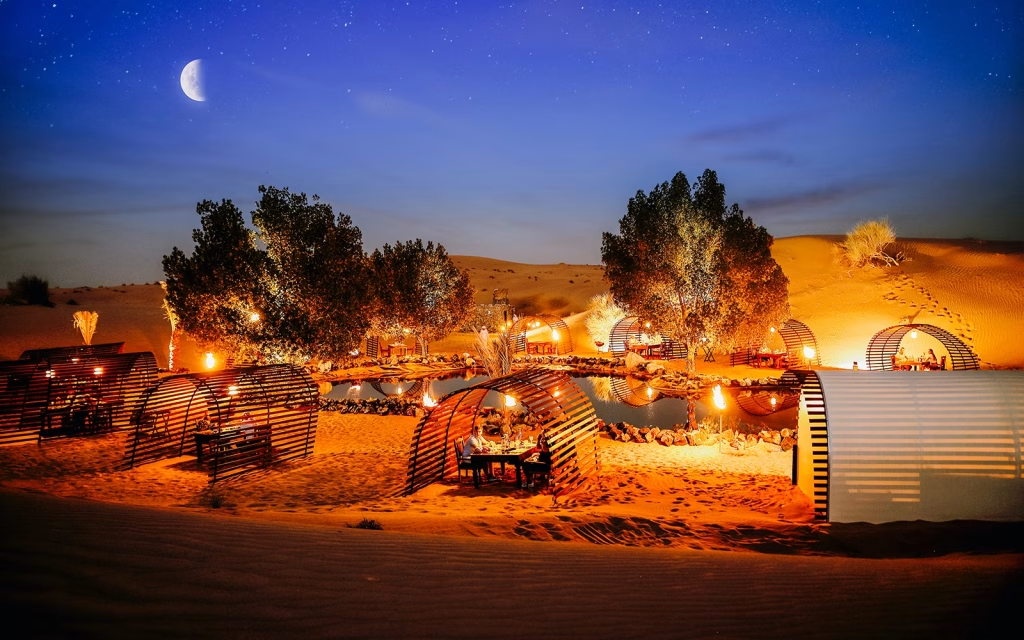Established in 2002, the DDCR is the UAE’s first national park and a UNESCO candidate site. It safeguards 5% of Dubai’s total land area, including rare ghaf woodlands and fossil-rich dunes. Unlike commercial desert camps, visits here directly fund conservation – 10% of tour fees support wildlife rehabilitation.
Booking the Right Tour
Only authorized operators can enter the reserve. Platinum Heritage offers sunrise wildlife drives in vintage 1950s Land Rovers with Bedouin guides. Arabian Adventures provides eco-friendly dune bashing in electric vehicles. For exclusivity, Al Maha Resort’s private tours include oryx-tracking with conservationists.
Pro tip: Avoid “desert safari” mass-market operators – insist on DDCR-certified guides. Check permits at the gate; genuine tours display the reserve’s falcon logo.
Best Times to Visit
Winter mornings (Nov-Mar, 6-8 AM) offer cool temperatures and active wildlife. Summer nights (Jun-Aug) reveal desert foxes and hedgehogs during full moon walks. Avoid midday year-round – temperatures exceed 45°C (113°F), and animals retreat to shade.
What to Wear and Bring
Opt for neutral-colored, loose clothing – bright colors disturb wildlife. Closed-toe shoes protect against scorpions (rare but present). Pack binoculars, a reusable water bottle (refill stations available), and a scarf for sudden sandstorms. Pro photographers: UV filters prevent lens damage from blowing sand.
Wildlife Spotting Strategies
The reserve hosts 230+ bird species, including lappet-faced vultures. Dawn drives near Al Qudra Lakes often reveal oryx herds drinking. Look for sand cat tracks near crescent dunes – these elusive felines hunt at dusk. Guides carry thermal cameras for nocturnal species like Gordon’s wildcat.
Cultural Interactions with Bedouin Hosts
Select tours include time with the Al Marmoom Bedouin community. Learn to read sand patterns for navigation, try fire-making with flint, or grind coffee beans for traditional gahwa. Respectful guests may be invited to temporary camps – always remove shoes before entering tents.
Photography Ethics
Never use flash with nocturnal animals. Drones are banned except for permitted research. The DDCR’s “No Trace” policy means no moving plants or fossils for photos. For iconic shots, the Seih Al Salam area’s star dunes glow red at sunset.
Unique Experiences Beyond Safaris
Join the Oryx Release Program (seasonal) – assist biologists in tagging rehabilitated animals. Desert Clean-Up Drives combine conservation with dune exploration. Stargazing sessions use Bedouin navigation techniques to decode constellations.
Family-Friendly Activities
The Eco-Camp offers junior ranger programs (age 8+) with wildlife tracking workshops. Night vision goggles at Al Maha’s hide reveal desert hares and gerbils. Teens can try archery with bows made from samar branches.

Accessibility Considerations
Modified vehicles accommodate wheelchairs on select routes. Visually impaired visitors can join tactile tours feeling animal pelts and fossil casts. The reserve app provides audio descriptions of key sites.
Sustainable Practices to Follow
Stay on marked trails to protect fragile microbiotic soil crusts. Carry out all waste – even biodegradable items disrupt ecosystems. Avoid loud noises that stress wildlife. Report injured animals to guides immediately (emergency vet teams patrol daily).
Seasonal Highlights
- Feb-Mar: Desert hyacinth blooms
- Apr-May: Oryx calving season
- Oct-Nov: Migratory bird influx
- Dec-Jan: Cool nights perfect for overnight Bedouin-style camping
Getting There Responsibly
The reserve is 45 minutes from Downtown Dubai via Al Qudra Road. Shared shuttle services from Hatta Express reduce carbon footprints. Cycling groups can enter via Al Qudra Cycle Path (prior permission required).
As the www.few.ae editorial team, we’ve partnered with DDCR rangers to craft this guide. Whether you’re a wildlife enthusiast or cultural explorer, the reserve offers profound connections with Arabia’s untamed soul – if visited with reverence.
Final Conservation Tip
Adopt an Arabian oryx through the DDCR website – your name will be displayed at the visitor center, and you’ll receive annual updates “from your desert ambassador.” Now venture forth, but tread as lightly as the desert fox at dawn.


 then "Add to Home Screen"
then "Add to Home Screen"